A Complex Compositions Collage
Before Rob got sick I had enrolled to do a Textures and Background - Complex Compositions course with Jane Dunnewold. This involved making a series of background printed papers/fabric using set techniques and then utilising them in collage. I still haven’t completed that first brief but I have tried to keep working. I chose to work in paper as a challenge and because I had plenty of large sheets of paper on hand, including some additional collage collected pieces.
I can’t believe it is over a month since my last post. On 6 June Rob was diagnosed with pneumonia and this developed into sepsis on his right hip replacement from 25 years ago. He was rushed to hospital in Hamilton and surgery and a long road back began. We have been told numerous times that he is very lucky to have survived. He was in hospital for 6 weeks during which time he contracted Covid and experienced blood pressure problems and heart arrhythmia. He is home now but still needing 24/7 care so being able to sneak out to the studio while he is having a nap has been a bit of a life saver for me.
Faces of India - the Astrologer
There have been so many ups and downs with Rob as he has battled sepsis, covid and internal bleeding that without my stitching I think I would have gone crazy. This thread painting of the Indian astrologer has been worked on at odd time throughout the process. Getting home from the hospital at almost dark and feeling like all I wanted to do was curl up and go to bed. It hasn’t helped that it has also been very cold - but that is to be expected. The coldest weather always comes after the solstice.
My faces of India are real people that I met and photographed on my textile tour of Rajasthan. This astrologer told me I would live into my 90s. If my knees remain this sore from arthritis that is not necessarily such a great thing to know. But it was amazing how much of my life he could interpret from my palm and my birth date.
Soft Sculpture Vessels
Having sat with Rob and slow stitched the sampler of various natural fibres. I then wrapped the sampler around some iron pieces and put the whole into a strong black tea solution. The iron in the bundle darkened the fibres considerably - in fact more than I had intended. I left the bundle in the tea solution for two days before removing and allowing to dry at room temperature. I decided I didn’t like the sample with the saddened colour so I decided to make it into soft sculptured vessels. I had some dried out beech leaves from the back lawn and I soaked these in water overnight and then sandwiched and stitched them between black organza. In doing this I found the process worked well and wondered if drying the leaves first and then rehydrating them was like drying natural weaving material that needs to be dried first and then rehydrated to prevent shrinkage of the original material. I am keen to experiment a bit more with these concept.
When I think about it Susanna Bauer who does amazing work with leaves and crotchet always dries her leaves first. A lightbulb moment perhaps.
These vessels are softer than the earlier sand covered vessel as I didn’t want to cover up the stitching and the applied leaves so I used gel medium to provide body to the vessels. I measured around some pvc pipe and stitched these into a tube and then used the base of the tube to create a pattern for the bottoms. For a bit on fun, I stitched feathers around the top of one vessel. The taller one is a piece of crotchet that I just mounted on some fabric and then rolled and left in the same tea solution but for a much shorter length of time. The fabric used is recycled cotton sheeting from the thrift store
Stitchclub Tutorial with Deb Cooper
My husband remains quite ill in hospital and I have been travelling back and forth most days to sit with him so he doesn’t feel so isolated. He contracted Covid from the hospital so he is now in a room on his own and I need to mask up when I go in.
So I decided I would take these sections of mainly natural fabrics and stitch them together with a bit of embroidery added. The idea is that once the strips have been completed they will be bundled with some rusty iron pieces and probably some leaves and put into a strong tea solution for a couple of days. They are resting in the tea solution now so it will be interesting to see what develops. And the stitching definitely helped to keep my more relaxed as I sat with Rob. Maybe I will have something to add next week.
When I have been at home I have been trying to reorganise the house for when he comes home. We have bot an electric bed and an electric lazy boy but shifting the furniture around to accommodate it is a bit of a mission. At the moment I feel like I am living in one of those homes where it is difficult to move around because of the “collections” Mine is mainly larger itens of furniture and as soon as the weather settles I will get the good will people come and take away the two single beds and the dresser that are no longer needed. In the meantime I am just working around them.
A Beach Walk Findings
This week has been an emotional one for me. My husband contracted bacterial pneumonia and the infection got into his blood stream and travelled to the site of his titanium hip replacement. At present he is in hospital unable to walk or put pressure on his right side. They are on top of the pneumonia now but he will need to have surgery to scrape the infection away from the hip joint replacement, He is waiting to go to surgery as I type this. I have just heard he will have a replacement ceramic hip put in and will need to stay in hospital for two weeks to make sure the infection does not reappear. Once he is clear of infection there will be about a 6 month recovery process. I have been traveling back and forward to the hospital each day and feeling exhausted by the time I get home so not much happening in the studio at the moment so I am posting this piece which was completed a couple of weeks back.
This piece was recently completed from Debbie Lyddon’s on line course with fibre Arts Take 2. When i look at it now it has an almost Maori weaving look to it but that has been accidental. The drawn threads and wavy edges were to represent the tidal movements. . The base of the ostrich foot foot (struthiolar populosa) hand freely in little windows made from copper wire covered eyelets. These shellfish are only found in the cooler waters of the Southern hemisphere. On the West coast beaches where the Tasman Sea presnts and ongoing onslaught the shells can be found in various stages of decomposition. The strongest part of the shell is the base. It is symbolic of the need for a strong base iall we do.
There are 10 windows with the “bases” hanging freely. the number ten in Pythagorean theory is the symbol of perfection and colpetion. we have 10 fingers and toes. Ten symbolises the completion of a cycle. These findings are the completion of the life cycle of the Ostrich Foot organism - the last identifiable portion before the waves pound them to indeginite fragments.
I have chosed the colours for this piece very intentionally. The dark to represent the West Coast iron sands and the light to replicate the shattered shell substrates. I have left the edged unfinished as a symbol of diintegration
At the bottom left, behind the pulled threads is a print on foil of a skyshap - barely revealed. This incorporates the idea of sand, sea and sky - the elements earth, water and air
Backgrounds for Faces of India
The weather has been awful and I have had trouble settling to anything. That is not unusual at this time of the year with the shorter, cooler and often wet days. Ii am very photosensitive and find this time of year challenging unless I set myself a prescribed target. I have almost finished the Indigo worker in my Faces of India series so decided to create some more background pieces for the next few portraits.
I am working on eco dyed cotton - old sheets to be exact so preparation is quite a business. The fabric must be scoured to remove any washing powder or softener residues and then the fabric needs to be treated with a tannin bath. I use sumac as it does not affect the colour of the fabric like some other tannins. The tannin must be extracted by boiling and then the fabric immersed for about an hour. Following this the fabric is treated to a potassium aluminium sulphate bath for about the same time. I usually pre-prepare fabric and then dry and store in a labelled bag.
It is almost too late to be gathering good leaves for eco dying. My liquidambar was almost destroyed in cyclone Gabriel last summer and many of the maples have already fallen. But I am not looking for perfect imprints. I am aiming at more natural shapes and colours to provide an organic background to the brighter machine stitching. I think I may have used too strong an iron blanket in this lot as the fabric has quite a dull grey cast but it will still be useful. The piece on the left was rolled and dyed in the microwave for 3 minutes. I haven’t used the microwave before and it may have needed a bit longer to extract the leaf details. The yellow is from a few onion skins I introduced for variance.
The other pieces were rolled around an piece of pipe and steamed in my fish steamer for an hour and a half. The imprints are quite dark due to the iron blanket but they will be good contrast for some of the brighter coloured clothing.
The next portrait I am going to start is “the astrologer” and he has a bright orange urban and gold tunic so one of the more somber fabric pieces should make a good foil for that. I have found some of my portraits are a little large so I am now scaling them down before I print them on inkjet OHP transparencies for transference to the eco dyed fabric. I will stabilise the back of the area where the portrait will be stitched and mount in a hoop to try and minimise puckering.
I use cotton for these prints because silk would be too fragile to take the heavy machine stitching that is involved. Silk would be easier to eco dye but I am stubborn and want to use recycled material where possible and bed sheets are a good option. I can often pick up single 100% cotton sheets at the thrift store for minimal amounts and with the cost of living biting keeping my art spending in line is a very real consideration.
Turbulence - Earth Pigments and Stitch
This is the finished piece from the earth pigments extracted from the bottom on my garden during Claire Benn’s course. The linen fabric was primed with freshly made soy milk (not store bought) and then the fabric was placed face down with some threads on a sheet of heavy plastic sheeting. The back was then printed with soy paint made from the fresh spy milk and my ground pigments. It was then left to dry so you don’t really know what you are going to get until it is dry and you lift fabric off the plastic. The underside is the right side of the art work. The threads are called thieves and absorb more of the colour where they are sitting and therefore create an organic pattern.
When I revealed the underside I was reminded of the turbulence of the sea on our west coast so decided to enhance that feature with a a range of French knots in different threads and weights. There are a LOT of French knots in there varying in colour and desnit of stitch.
As I worked I began to contemplate more meanings of turbulence - instability, conflict, upheaval, tumult, troubles unrest. The dictionary meaning is a state of conflict without any order. So the physical characteristics of the sea began to also represent the metaphysical one of psychological upheaval where conflict begins below the surface and suddenly erupts in uncharacteristic outbursts. As I was stitching images of Gaz and Ukraine flitted acros the television screen so yet another vision of turbulence was brought to mind.
Below is a close up showing more of the French knots in colour and density. The piece is mounted on a stretch canvas and I had a very difficult time getting the corners to sit nicely.
Faces of India 2 - The Indigo Worker
Getting to the end of this thread paint now. You can see where the hoop has been attached for me to work on the neck and clothes area
Last March when I went to India we visited Bagru where the dabu dying and indigo printing was a major activity. This man was part of washing the huge bundles of indigo dyed fabric They were in vats and got into the vats with the fabric so he had a blue cast to his skin and clothes. I have tried to emulate in this thread paint. The image below shows my preparation for the thread painting. I use a basic citrus cleaner transfer method and then mark out the areas I want to work on with polychroma pencils
I am hoping to get at least 6 faces stitched on eco dyed fabric for the Waitomo Society of Arts exhibition in September
Faces of India Series 1
This week I have made a start on my Faces of India series,- a direct outcome from my trip to India last year. Part of my original excitement of going to India came from experiencing photographs of Steve McCurry and the opportunity to collect my own photos for artistic exploration.
In September 2024 the Waitomo Society of Arts will hold its annual art exhibition. I have always put in some entries and this series would be a great opportunity for this year.
I have printed the original photo in larger format using the free imagy app and printing onto inkjet transparencies and then transferring those images onto my own eco dyed fabric.
The first one I selected is this man with the hat and moustache. Not finished yet but each of these thread paints take many hours of work. Often some areas are worked over two or three times to get the effect and colours I am wanting. Unlike paint you can combine threads but you cannot mix them to achieve a colour result. I do not use black or white thread as these have a deadening effect on the outcome. I tend to use dark green or dark violet to get depth. In this photo the shadows in the hat are dark lilac overstitched with a dark green, It has achieved the effect of a mottled shadow from the brim of the hat.
In the gallery above you can see an early photograph of the Man with Moustache in process. The fabric is stabilised and set up in a hope to try and eliminate puckering. I am putting a heap of stitches in a very small area and puckers can easily creep in. There are a few around his hat in the left hand image but these should be able to be smoothed out. The centre image is a close up showing the detail and number of colour change levels around the eyes and the right hand image is the back of the piece demonstrating how in “sculpting” the colours, the direction of stitches remains very important.
I tend to use a very small straight stitch and free motion embroidery, keeping the hoop moving in random directions at all times to avoid stitch “lines” except where I want to emphasise a line - like the brim of his hat. Some free machine thread painters use a zigzag stitch but I do not feel I have the same control with this as the straight stitch.
I still have the lower portion for this portrait to complete but I am relatively pleased with the expression on the face now.
Making Pouches
This began as an exercise in using stiffened fabric to make pouches with eyelet custom eyelet holes. I had been to the thrift shop and found some white fabric but didn’t realise till I got home that the fabric was laminated heat fabric. i began just using the fabric to practice the eyelets which are made by winding light wire around a pencil and then buttonholing over the wire into a small hole cut in the centre.
I hadn’t intended to make these in such striking stark simplicity but I thought about trying some stencils a friend had given me that featured NZ flora. c to paint really well so I decided to contine in my little series. I will probably add a chain through the eyelets. There are a matching pair of eyelets on the back of the pouches. I have squared off the bottom corners and will probably use these to place so walk pickup in the pouches - like seedpods for the various stencils
Soy Milk as a Mordant
I have learnt a lot about the use of soy milk as a fixative and as a mordant during my study of earth pigments. Primarily to use soy you must use fresh soy milk that has been made that day from beans soaked overnight and blended with water prior to use.
I had tried soy milk as a mordant in earlier eco dying attempts but never been very successful. That was because I tried to use off the shelf store bought soy milk. So i decided to give this ago.
The example above was made using scoured cotton and soaking the cotton in fresh soy milk for about 30 minutes before making a bundle and steaming it. I omitted to give this fabric a tannin bath before using it so the liquidamabar leaves have not printed well but the maple, cotinus and forest tulip leaves have all transferred successfully. The cotinus leaves were fresh but the others were taken out of my freezer and rehydrated before use. I think a tannin dip would have further enhanced all the prints.
A Little Bit of Collage
I am not really a paper worker but I recently watched some short videos on a Collage Summit that made me think it might be fun to try some of this layering. I started off to make some cards and then decided to continue to make a covered box to house them. On the top of the box I have laminated a small MDF covered piece from making artist trading Cards from a long ago exercise
I started off by laminating a layer of neutral torn papers. It looked pretty messy but when the glue had dried, I added some white and bronze paint by dabbing the paint on with some bubble wrap. You can see how this looked in the second image below. Then I cut up the cards into regular sizes.
To decorate the cards I traced some women’s heads onto tissue paper - the exercise had used Muses. I carefully tore around the images and laminated them on to the individual cards. The tissue paper disappeared with just the drawn image showing, image 3 above. So I began decorating the images with small torn pieces of paper and a little bit of paint. I will probably find some appropriate words to go on them before I am finished. The cards fit neatly into the decorated box
Earth Pigments on Textured Grounds
This is an interesting concept and something I would like to try more of. The texture above was made from some old concrete at the back of my house. My house was built on the foundations of an old butter factory so some of the concrete is old and stony.
I presized some scoured linen with fresh soy and lay this on the concrete. Then I painted it with a soy pig paint made from soy milk and yellow ochre earth pigment and left the cloth to dry in situ. The weather was quite damp so it took ages to dry but the lovely pattern on the cloth was worth the wait
I think I would make a stronger mix in the future to enhance the pattern. This could be achieved using wood or cobblestones on rough concrete to achieve a different texture.
A subtle print with Soypig
The interesting thing with this method of working is that the soy milk “size” impregnates the fabric and will fix the pigments in the cloth at the painting stage. It does require 4 weeks to cure so that the fixation is complete. The pigments in the soypig paint drops through the top surface of the fabric to be revealed on the underneath of the cloth so when the fabric is dry the reveal is often a surprise.
I am working on a heavy weight plastic sheet so I can move the painted fabric around while I wait for it to dry without disturbing the sinking pigments. This piece is on white linen that has been scoured by washing in the washing machine on a 60 ° wash with 2 tablespoons soda ash and a teaspoon of Fairy dishwash (neutral soap). Scouring removes any finishes or starch etc from the cloth that might interfere with the natural process.
Claire Benn calls the process of painting soy milk on the fabric “sizing with soy”. I worked on damp soy cloth and this has to be done the same day as the soy milk is made (see previous post). I kept the sized cloths in a zip lock bag in the fridge while waiting to use them Or the sized pieces can be dried and put aside for use at a later date. I haven’t had much joy with working on the dry cloths so I will spritz the fabrics with water to dampen them before I use them (paint them) in the future.
I mixed 1 teaspoon to 100ml of soy milk to make my soy paint. The soy milk is added gradually to the pigment so as to avoid lumps or clumping. This piece used the pigment sourced from the bottom of my garden. I placed some lengths of end thread from the linen under the fabric (on top of the plastic) - Claire calls these “thieves” and then using a cut back chip brush I painted the soy pig paint across the fabric.
As i am primarily a representational artist, this way of working forces me into abstraction and I was delighted with the result. I am calling this piece “Turbulence”. To fix the soy and pigment permanently on the cloth there is a four week “curing time”. And then stitch can be added to enhance the cloth. This is the stage I am at now with this piece.
This final image shows the side I painted with the soy pig. You can see the shape of the thieves vaguely on this tip side but it is quite darker and different to the underside where the soy pig paint has dropped down through the fabric.
Earth Pigments
It seems articles about earth pigments and creating your own art materials are everywhere - or is that just because I have become aware of them. I do note I have in my library a couple of books like “Organic Artist (Nick Neddo) and “The Organic Painter (Carne Griffith) so it has obviously been at the back of my radar for a while.
So when Fibre Art Take 2 offered a course with Claire Benn (UK) called out of this earth and focused on the concepts of soy milk and earth pigments (either hand made or sourced from eco suppliers) I was ready for the challenge. And what a challenge it has become. Claire is well known for her surface design work with fibre reactive dyes but over the past few years she has worked almost exclusively with soy milk and pigments in abstracted compositions. She is a great teacher with so much encouragement to just try things and anyone wanting to learn more about this process - rather than just my achievements through the next few blogs - would be rewarded with enrolling for the next intake with Fibre Arts Take Two.
It has been an interesting journey for me as I am primarily a representational artist and struggle with Creating abstract work that I am happy with. The unknown “reveals” in the soy pig process have helped me to look differently at my work
The earth pigments are locked in place with the protein within the soy milk. It is essential that fresh whole soy beans be soaked and then ground each day as the soy sours quickly without all the additives found in store bought soy milk. That was my first hurdle - finding whole soy beans (not split) to work with as the biosecurity standards make whole soy bean access a little difficult.
Back to my earth pigments. In the photo above I have taken some earth from down by the spring - this is the same earth I used for the dabu dying. I dried the soil and then ground it with a mortar and pestle. It was then sieved through a standard kitchen sieve. A second finer sieve was then used to reduce how fine the particles were. It should then have been mullered but mullers are quite expensive so I tried to grind my fine particles on a sheet of glass with a flat bottomed candlestick.
My final product was lighter than I anticipated but I was not disappointed with my result
Earth pigments are available in a whole range of colours from art supply stores but the prices vary quite a lot. I purchased a yellow ochre, a green and a black powdered pigment along with a sample set which enabled me to try pigment colours that I might want to use more of in the future.
Fnally I was ready to make my soy paint using one teaspoon of my pigment to 100ml of freshly prepared soy milk
Knitting with Convolvulus
For some time now i have been playing around with weavable vegetation form my garden. Convolvulus (Bind weed) is a perennial weed that causes me quite a bit of grief trying to stay on top of its rampant nature. Earlier I posted a small bowl that I had made from it. Now, after reading about Alice Fox’s investigations with the vine, I decided to try knitting with it and making a textured wall hanging.
Here is the result. The convolvulus vine was cut, leaves stripped and the vine coiled and dried before rewetting for pliability and knitting on No 8 needles. I started each new piece at the beginning of a row, weaving in any ends at the side. The darker area is a part of the root vine whereas the greener parts are those that travel up to the light.
The finished piece was stitched onto a linen mix substrate and that was stretched onto a piece of thin MDF and mounted in a box frame without glass. I prefer the texture to be readily visible rather than confined behine
Dabu Dying with Thermofax Screens
I had some mud mix left over so decided to see if this would work as a resist through a thermofax screen and then dyed with Indigo. Of course I could play around with this sort of process indefinitely and I already had some scoured cotton sheets ready to go so I was off running. I have been sourcing flat 100% cotton bed sheets from thrift shops as they make great substrates to work on at a really affordable price and give me scope to experiment and play with
My eldest daughter is a mad chicken lady - she has around 400 chickens. She breeds pullets to sell for those wanting to have their own “egg Factory” and also sells fertilised eggs after candling them to insure they are fertile. It has been a god send to her since her husband passed away with cancer 2 1/2 years ago. She only has Barred Rocks and black Orpingtons so this screen, which was a commercially prepared one seemed a good one to start with.
The first image above is one of my own thermofax prepared screens. The Second is one of Jane Dunnewold’s screens which I have used extensively in my work before getting my own thermofax generator. The third print is a very delicate print of tui from one of my thermosfax screens. Perhaps too detailed a line drawing for this type of resist but could be used to stitch into. The bolder prints seem to work best with the dabu dying resist method
So That is How Caterpillar Books are Supposed to Work
I have made caterpillar books/snake books before but I was never quite sure how they were supposed to work. Mainly because the last very important step had been missed from the instructions and that is gluing the internal pages together so the book stands as a book and no longer wants to unfold in a complicated manner.
In Debbie Lyton’s Sensing Place course (Fibre Arts Take 2) we were encouraged to take a walk and create small sketches of a considered moment on that walk. I think we were supposed to sit and do this but I decided to incorporate the exercise with a walk to the Three Sisters Rocks at Tonagaporutu. I had long wanted to do tis walk but they are only accessible when the tide is out (half way or more) and my husband isn’t up to walking that distance since his lung cancer operation.
I was to collect some delicate ceramics from a home based potter in new Plymouth and I planned my return trip so that I would catch the tide just right. For any artist the trip is a delight of huge monolithic structures, textures, caves and the ever present sea
You can join me on my walk on the slide show below.
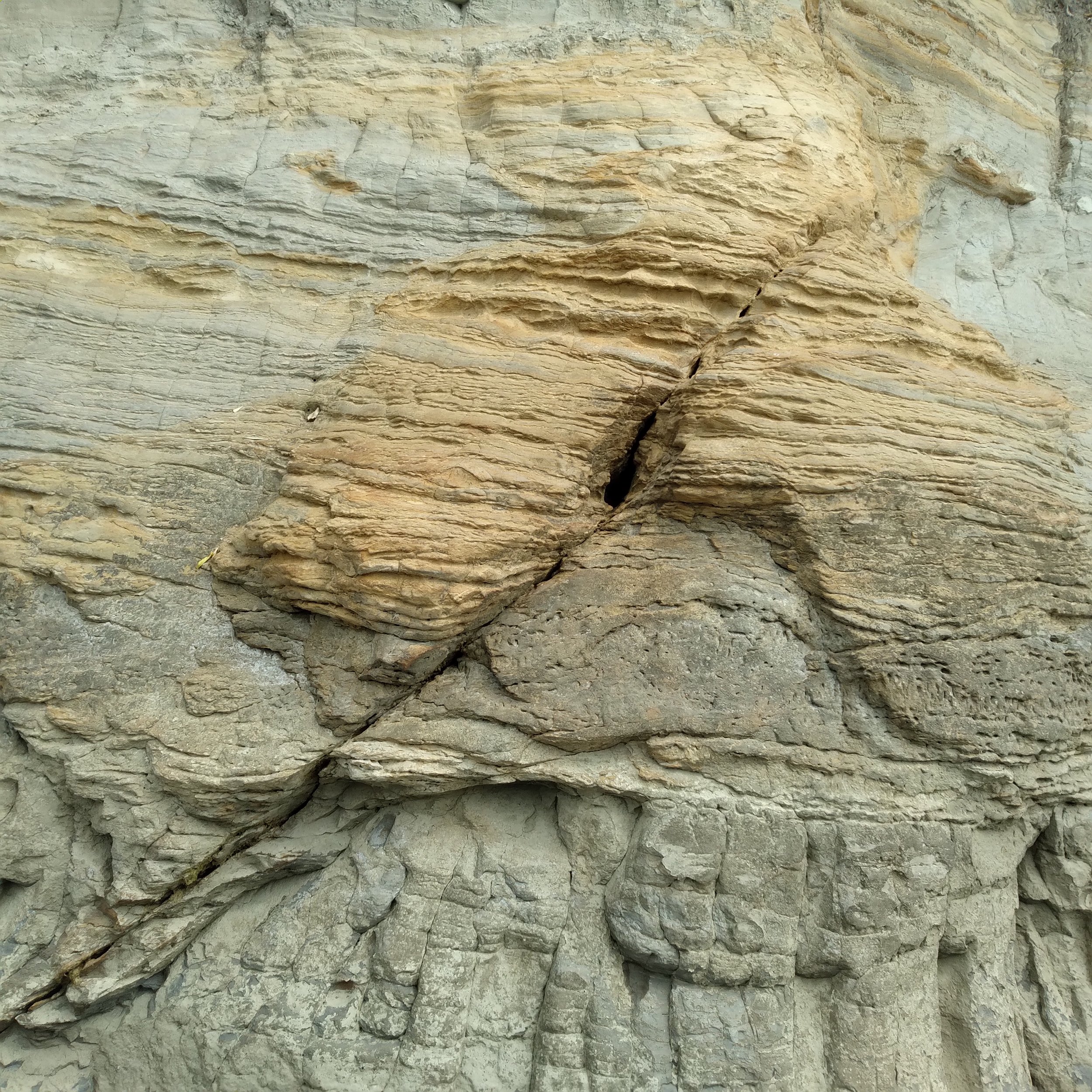
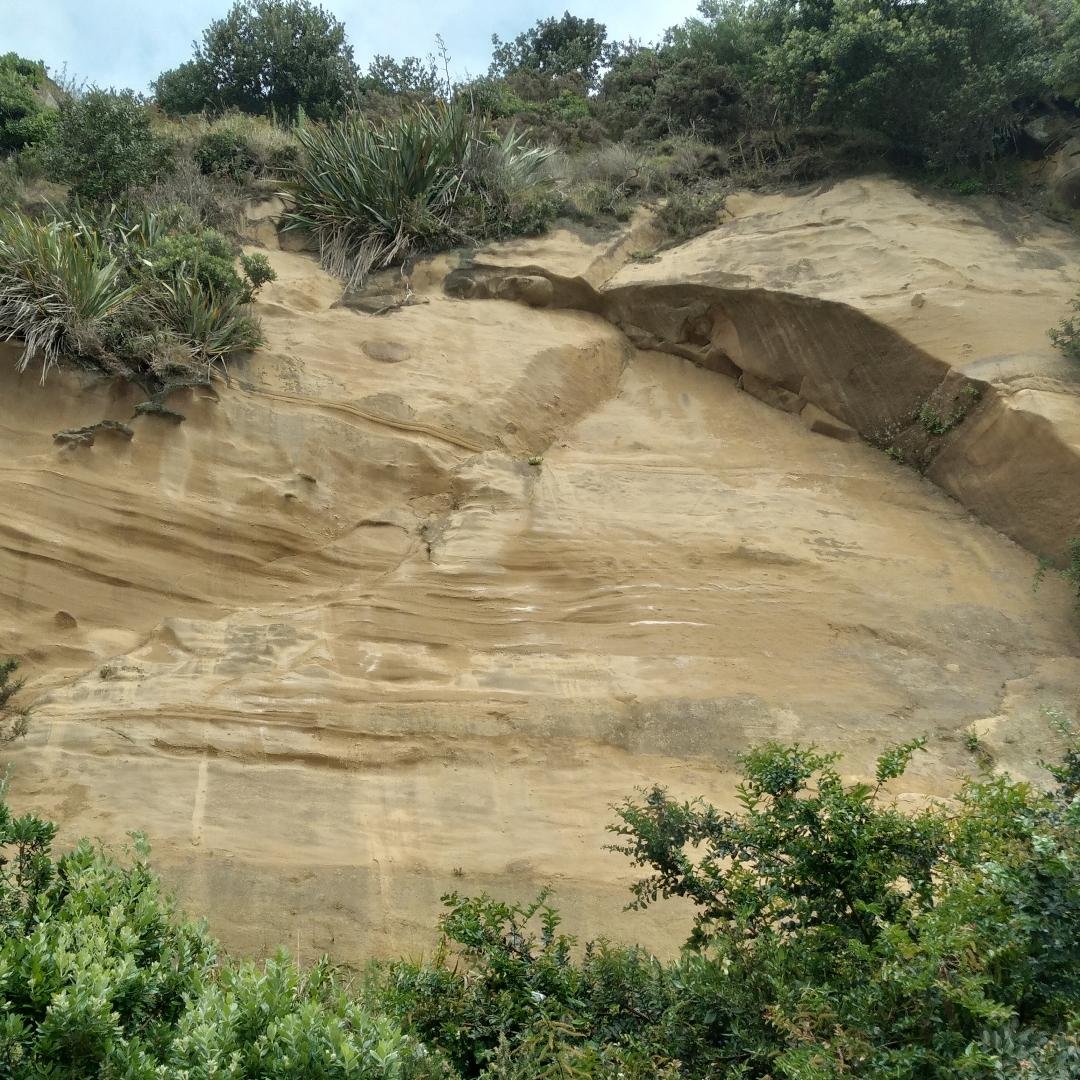

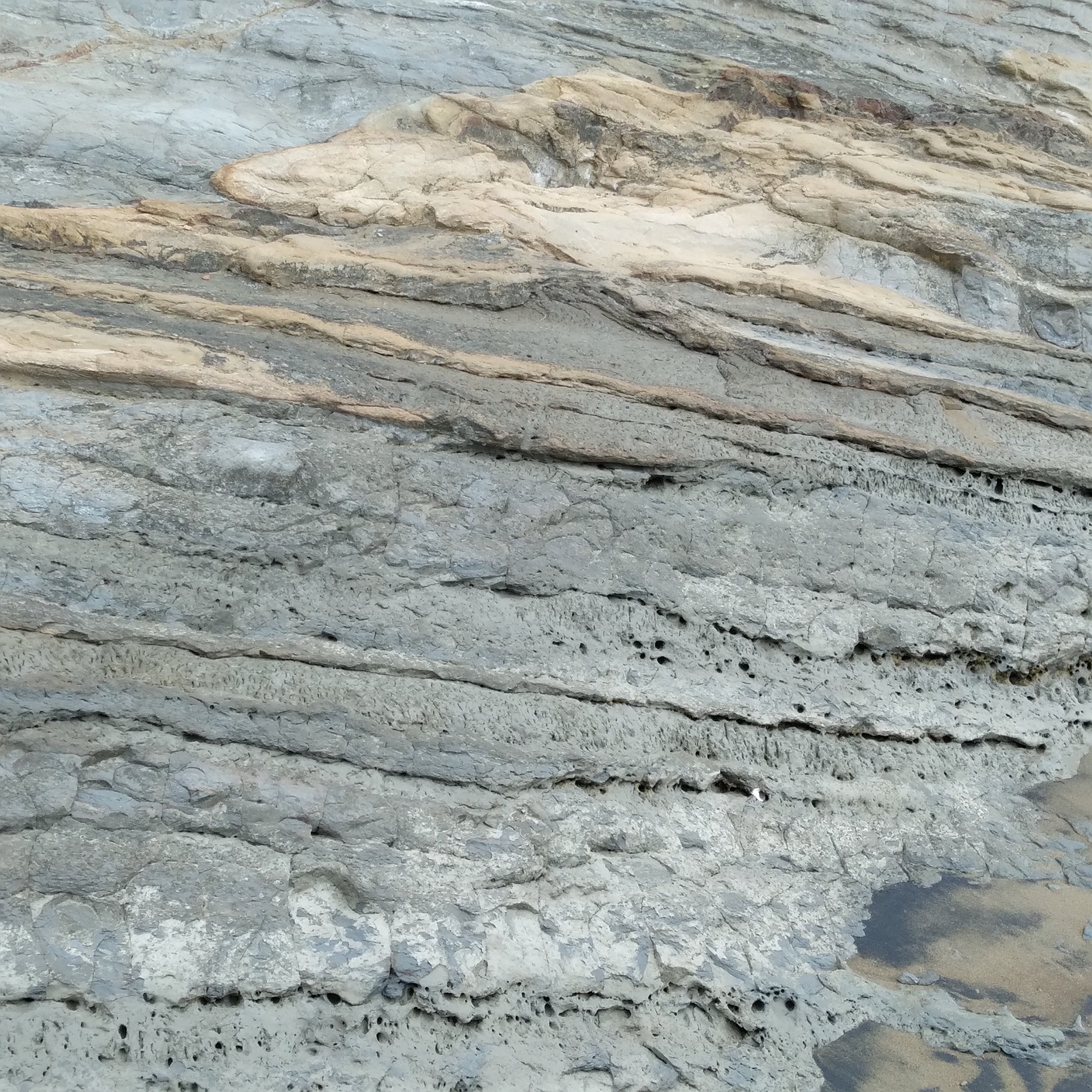

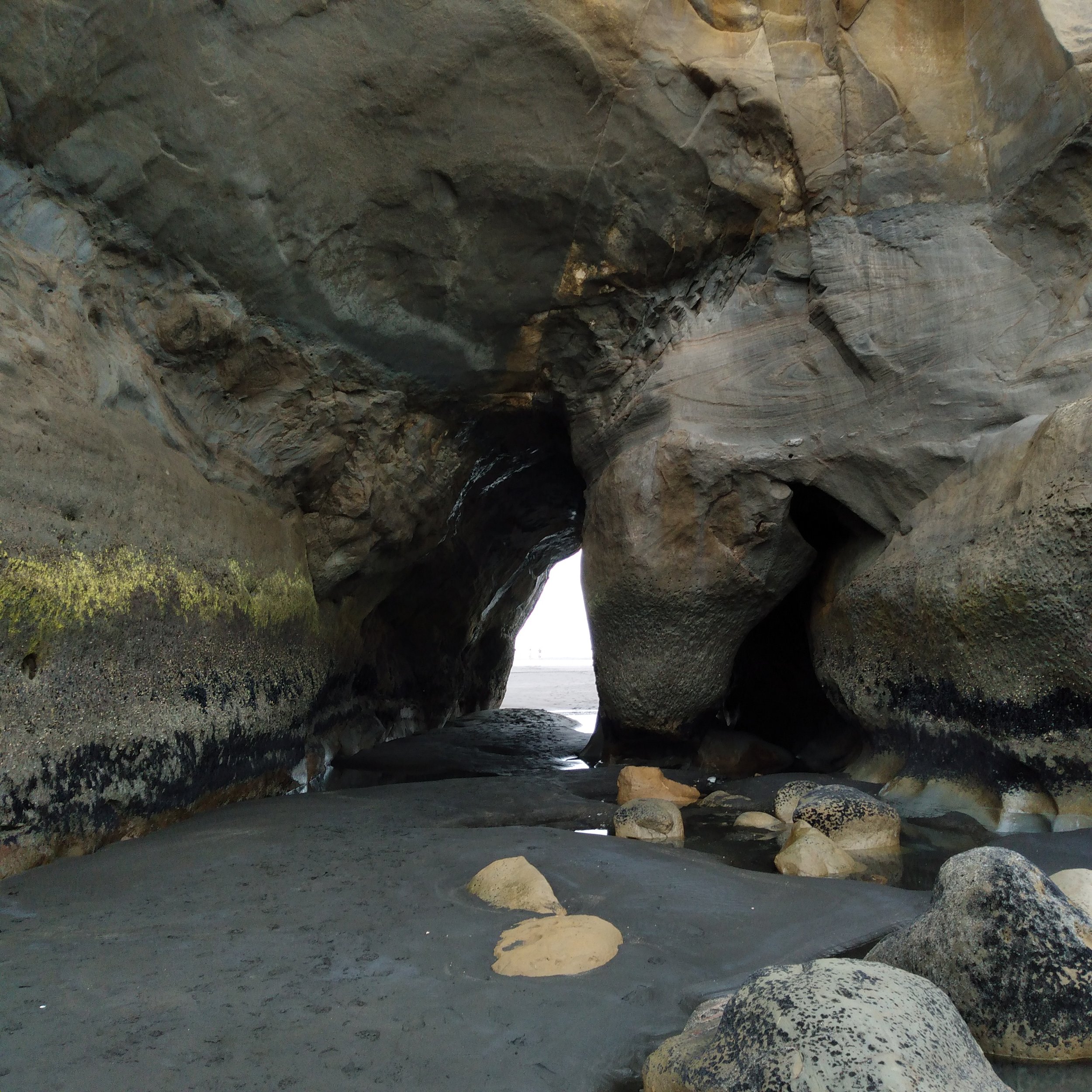
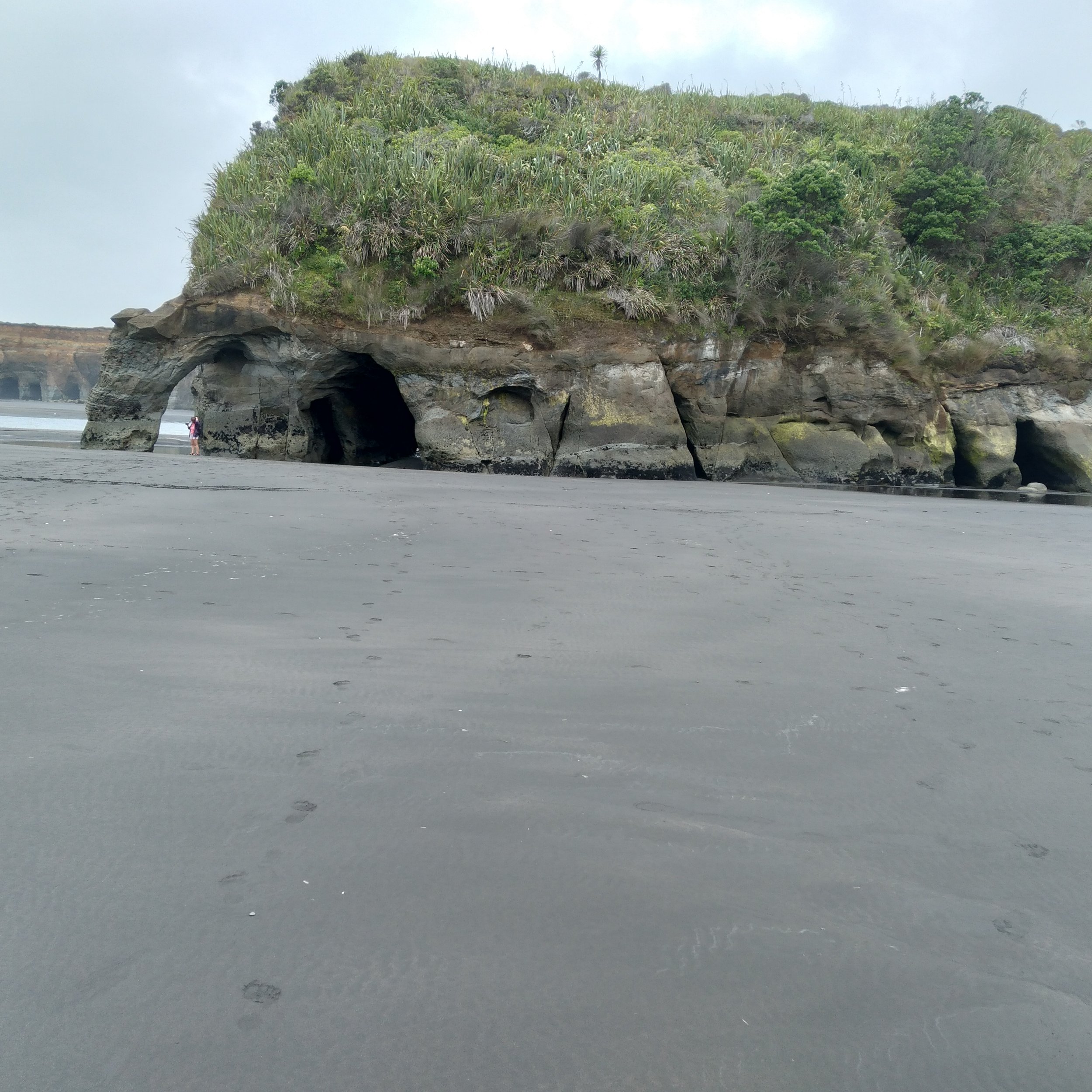
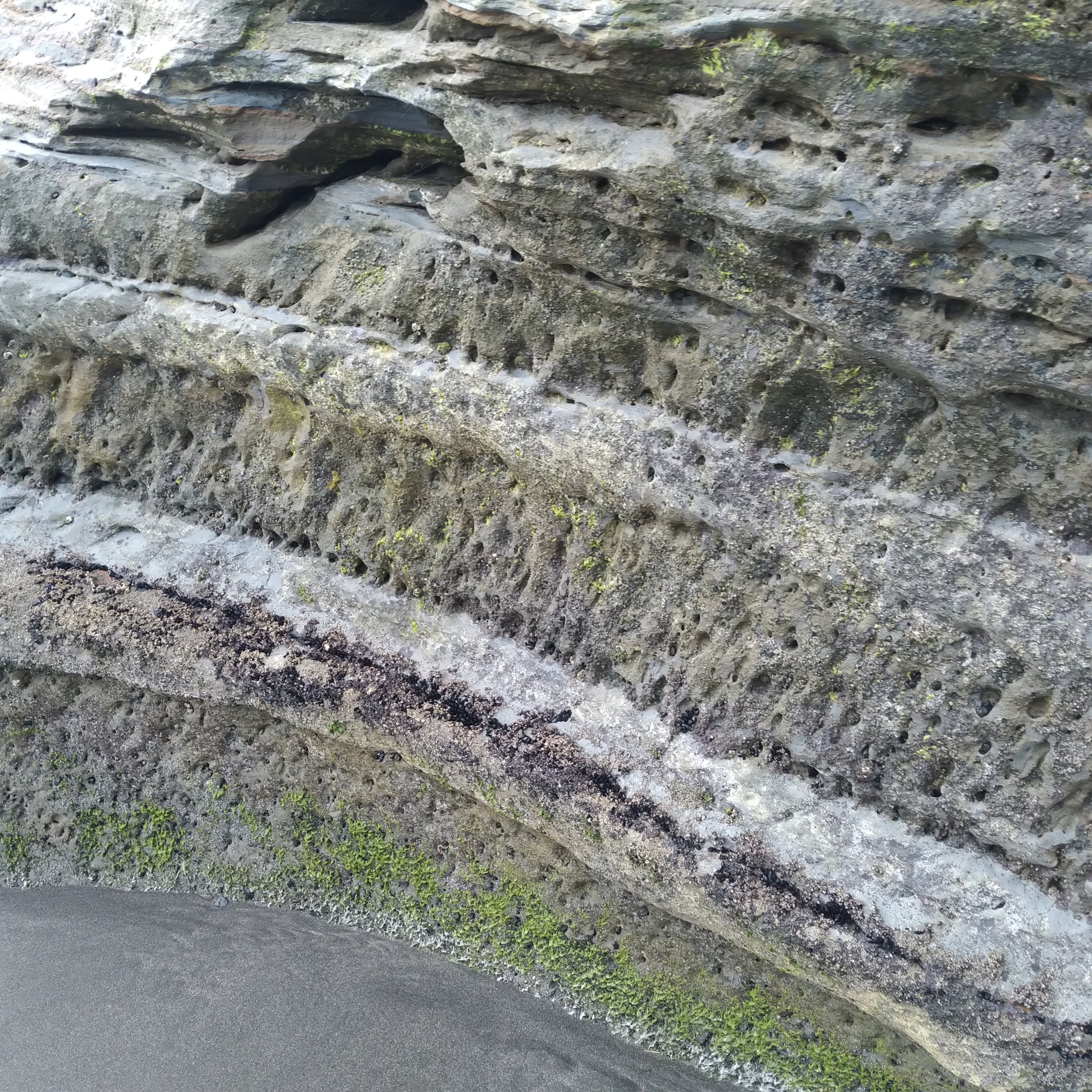
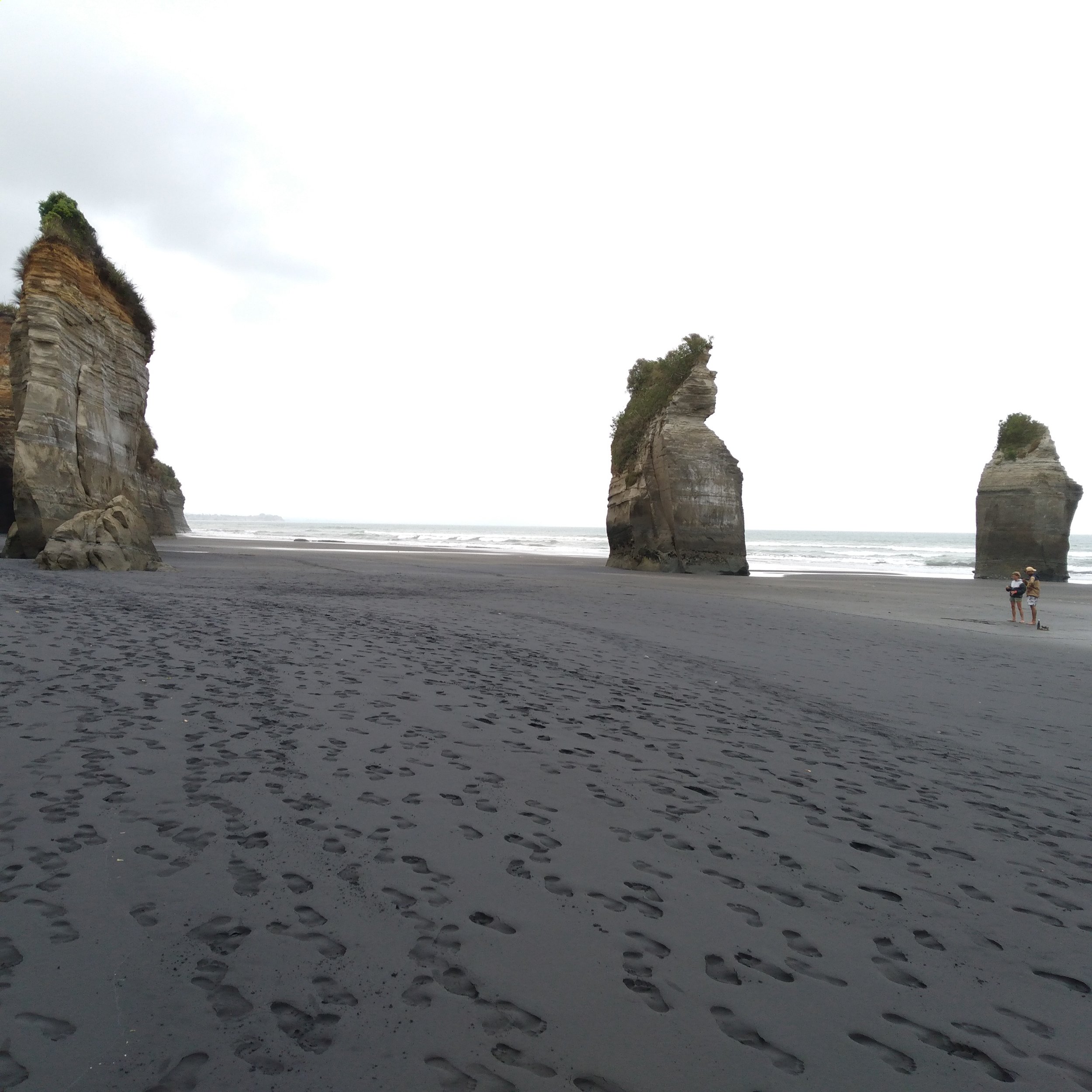
We were encouraged to use descriptive text to insert into our caterpillar book.
Here is my text:
The sun is warm on my face
The half tide sea, cool on my feet
Tide patterns forming against the strata rockface
I hear the drips of water cascading
The quilted rocks rise up above me
Sea worn caves of dark secrets
Tunnelling through to peep hole visions
Water flowing, tide ebbing
Glimpses of coastline through the openings
The Tasman sea forever lurking
Sentinels standing - Three Sisters
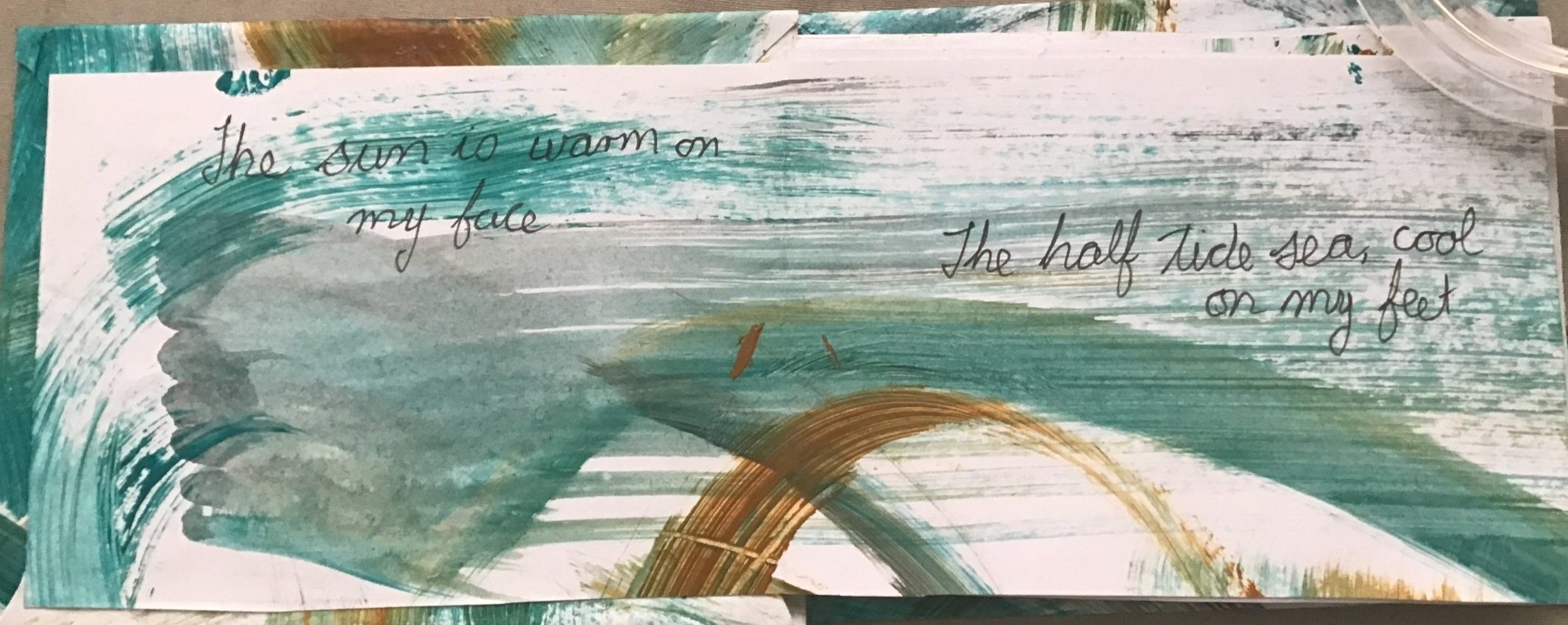
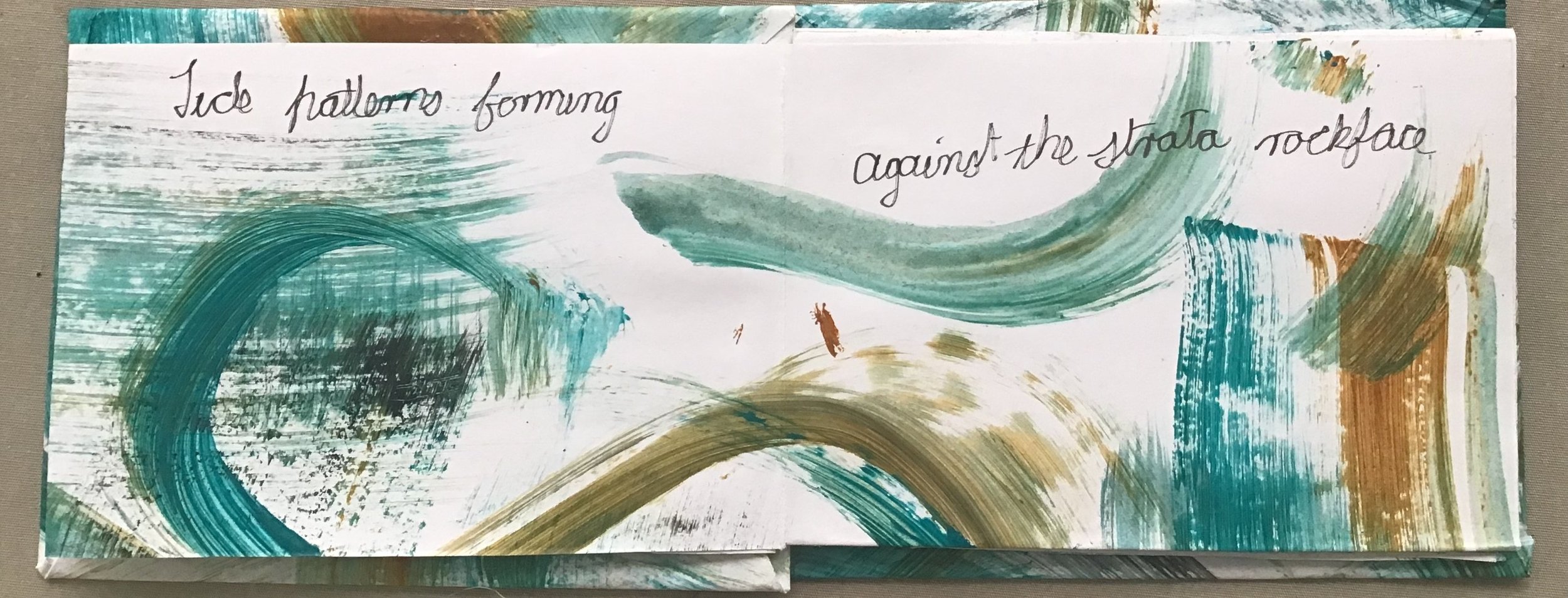
![IMG_8680[1].JPG](https://images.squarespace-cdn.com/content/v1/639f6bda61e0456d11776132/1709526148443-ZULEWDGBFFJOXZJD030C/IMG_8680%5B1%5D.JPG)
![IMG_8681[1].JPG](https://images.squarespace-cdn.com/content/v1/639f6bda61e0456d11776132/1709526224734-IQCCUC9BJ2Z23QZYGZ6U/IMG_8681%5B1%5D.JPG)
![IMG_8682[1].JPG](https://images.squarespace-cdn.com/content/v1/639f6bda61e0456d11776132/1709526276489-1F0MUZGKRAMRML6C8AYM/IMG_8682%5B1%5D.JPG)
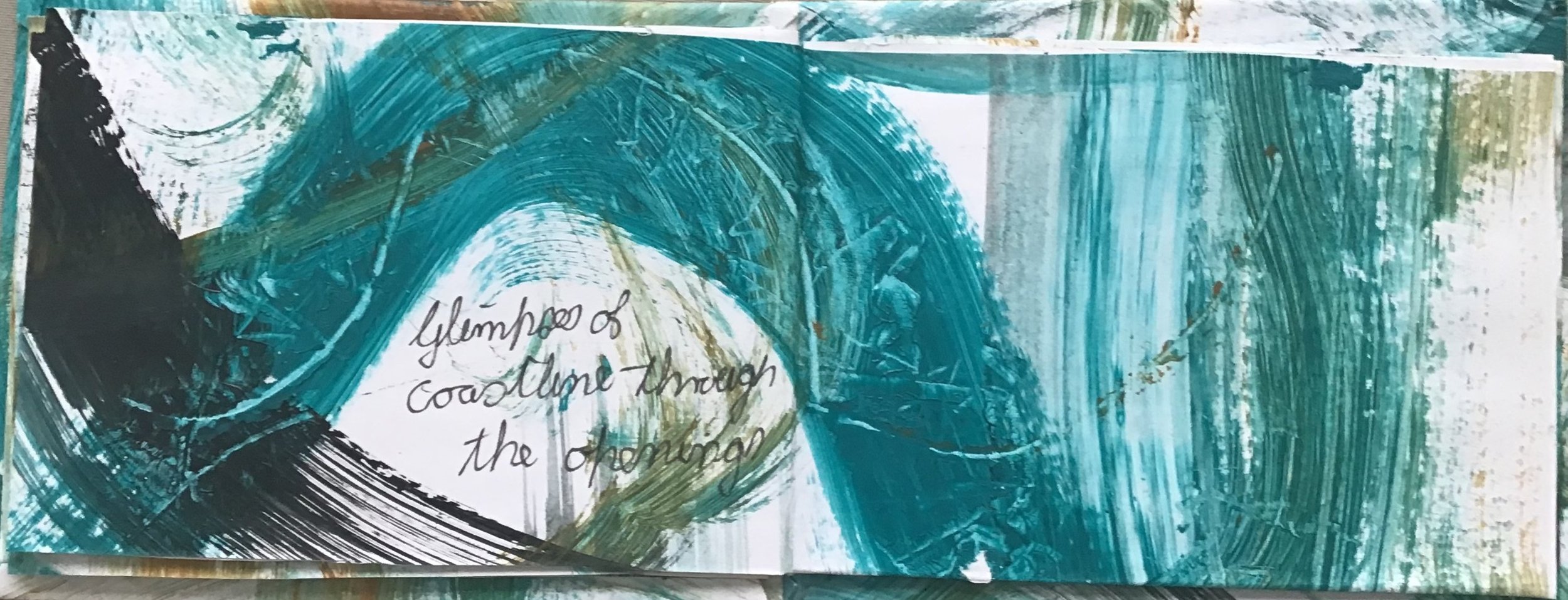
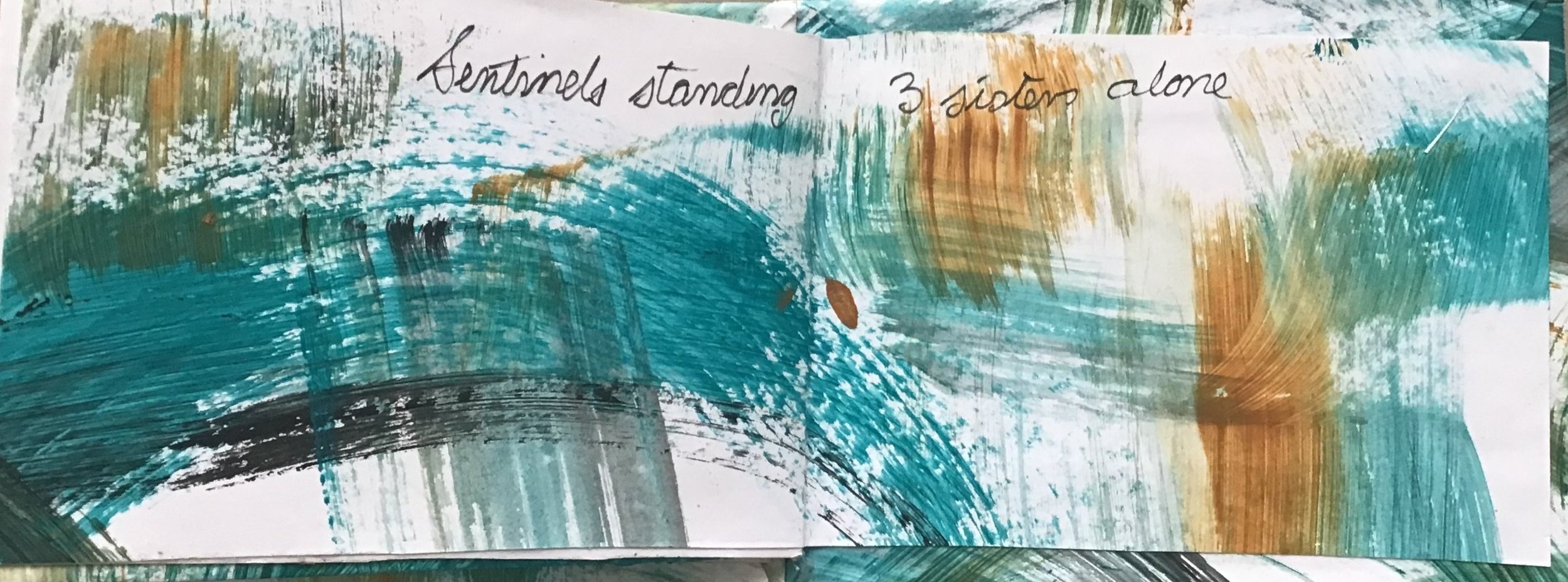
I chose turquoise burnt umber and black to paint two A3 pieces of paper using various mark making methods. Once the paint was dry, I folded the paper in half long wise and pressed with a bone folder. Then I folded each subsequent side into this middle fold and pressed with a bone folder.
I folded the short (portrait) sides of the paper in the same way. The result is 8 segments. Decide on whether your book is to be a portrait or landscape book (mine is landscape) carefully cut up the two outer folded lines through 2 segments. On the middle fold cut down in the opposite direction two folds.
The sections can now be folded up and down to create a pile of the folds. This is the part I had always missed. The blank top and bottom sections will be glued onto the covers. Open out and mark the rest of the blank sections 1 and 2 so you can identify which ones need to be glued together. Glue those blank sections (a 1 to a 2) down so the book now only opens as a traditional book.
Measure and cut two pieces of cardboard slightly larger than the book for the covers. Cut two pieces of paper 1.5 cm wider all round than the cardboard. Glue the cardboard and place in the centre of the papers. Press well with a bone folder. Trim off the edges at 45° close to but not right up to the corners of the card. Fold down and glue opposites ends of the covers. Pinch in at the corners to create tidy corners that do not have dog’s ears. Glue the inside of the cardboard to the blank front and back of the caterpillar book. Press under a weight over night.
These are delightful little journals that can be used for any number of recording ideas. In this case I have recorded my walk to the Three Sisters, but I am very tempted to make one for sitting in my garden, listening to the cicadas at this time of year
Back to Dabu Dying
Dabu Success!!!!
After i returned from India last March I was really keen to have a go at Dabu dying. This is an indigo based dying process that uses black mud as a resist. I had told the proprietor of the dabu factory we visited that I was from a lime rich area and he kindly shared the proportions of Lime, Arabic gum and mud, telling me I must practise when I got home as it was an art form that was in danger of dying out.
I tried but I did not have an indigo vat at the time and tried with tumeric. The pattern was there very lightly but not enough to be easily discerned. I decided to wait till Summer and set up an indigo vat for the purpose.
Well time has moved on and Summer is almost over - in fact we are in the first few days of Autumn if you go by the traditional calendar. So I decided to set up a new trial making sure everything was as close as possible to what I experienced India.
I used an Indian wood block in the shape of a scallop shell and an offset printing in rows. My mix was a little bit runny and I dropped a couple of blobs from the block onto the cloth. You can see in the second photo where I have attempted to sponge these away. My fabric was a 100% cotton sheet that I had sourced from a thrift shop and scoured with soda ash and alkaline neutral soap at 60 ° in the washing machine
I created the Indigo vat by using a kitset that supplied 100gm soda ash, 50 gm sodium hydrosulphite and 20 gm of pre reduced indigo. I mixed it in a bucket with a lid that I have used for indigo dying previously and after 15 minutes or so a nice “flower” was beginning to form on the top of the vat. To test if the vat was ready I placed a small strip of cotton tied in knots into the vat, waited a little bit then carefully lifted it out. Care must be taken not to introduce oxygen into the vat or it will expire. It came out green as in the photo below of the strip on the yellow bucket lid. The magic of indigo started to happen almost at once. In went the Dabu prepared piece. Left it for a little and then took it out carefully. By the time I got to the clothes line it was already turning blue. Where the fabric had been folded was still green as it had not oxidised but a few minutes on the line and the blue was pretty uniform - even where I had to sponge off the blobs.
I wondered if the soda ash in the mix would offset the process of scouring. Would the soda ash in the mix mean you could place a pre printed white on white piece of commercial dyed fabric in the vat and would the print act as a resist. I have had some rather lovely results with preprinted commercial fabrics but I have always scoured them first. I trotted off and found a fat quarter. Into the vat it went and the results looked promising. We will see when it is washed how well that process worked. That is the last photo in the gallery below.
Now I have an indigo vat and will have to work at creating some interesting results this next week.

What is my current Textile Focus
My interest in textile art is wide and varied. My focus at the moment is on completing panels for my scholarship project Parallels in Maori and Celtic customs and art. I am currently working on a Tromp L’oeil piece that represents the Winter solstice coming through a gap in the hills that was important to both cultures in mapping their seasonal world. the centre piece is hand embroidered and now I am trying to complete the effect of adding small pieces fabrics to create the effect I am looking for













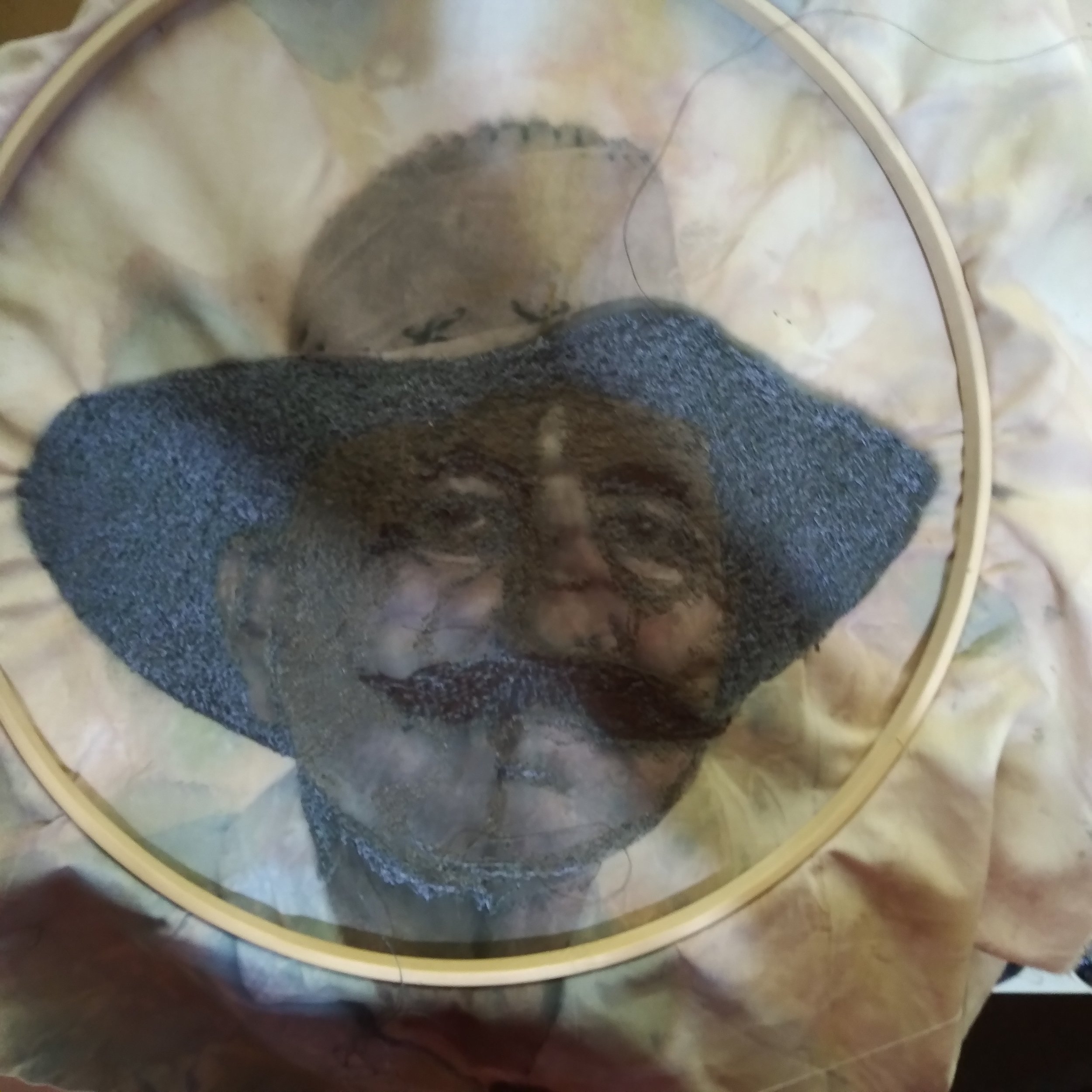
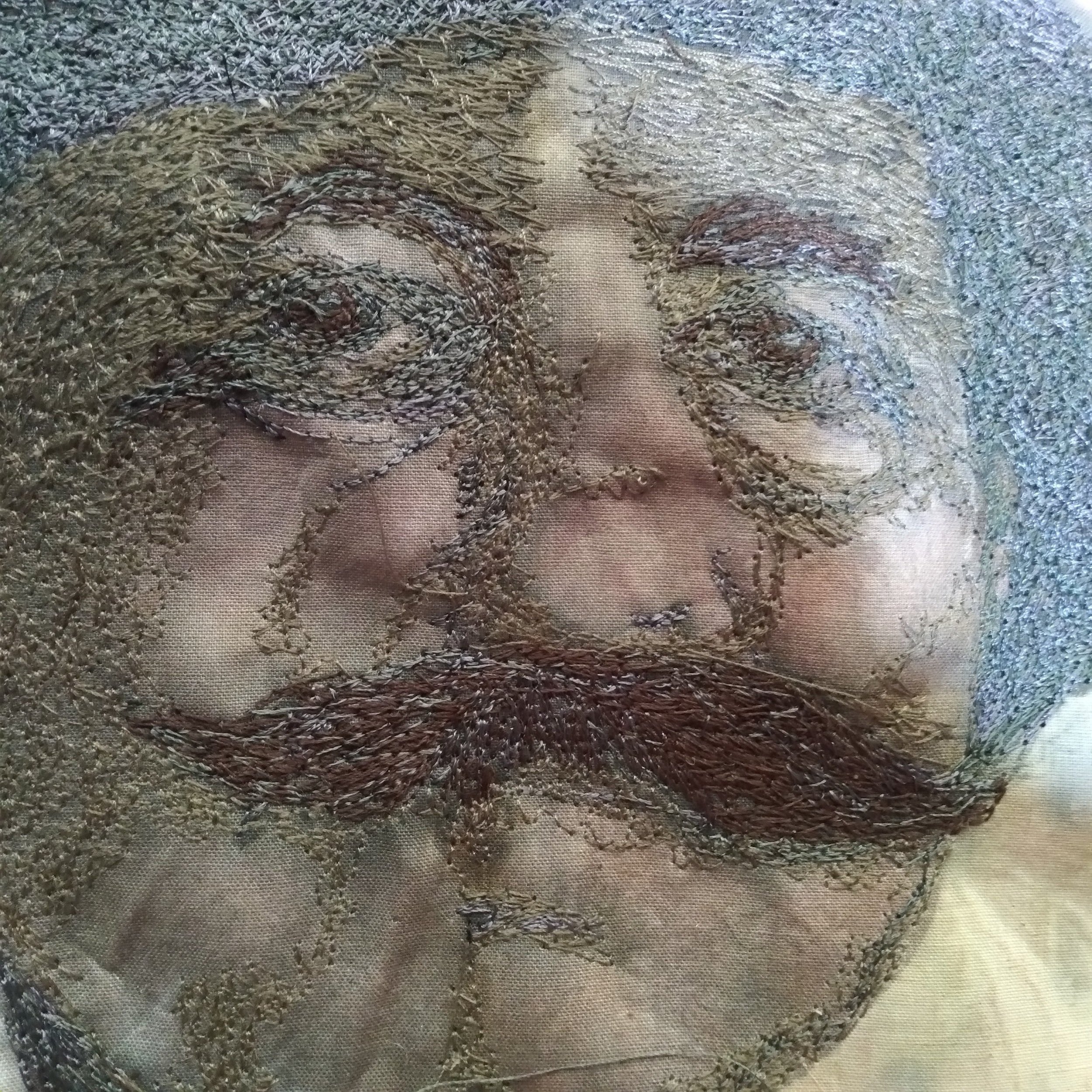
![IMG_8852[1].JPG](https://images.squarespace-cdn.com/content/v1/639f6bda61e0456d11776132/1715223629552-Z475Z59GVTWRA43UMNR7/IMG_8852%5B1%5D.JPG)

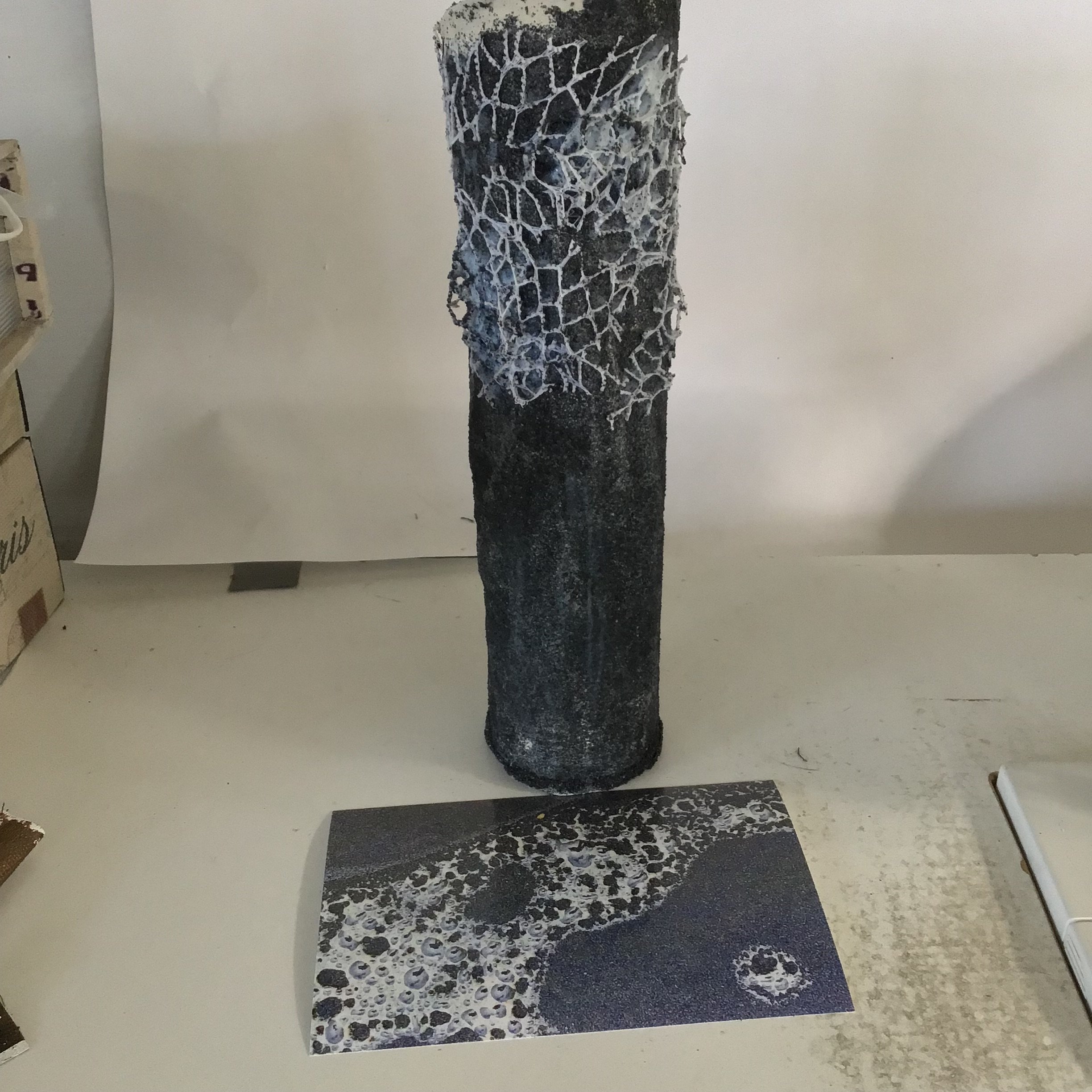


![IMG_8752[1].JPG](https://images.squarespace-cdn.com/content/v1/639f6bda61e0456d11776132/1712725748506-AMDT0WUYU6QRKALPMK9C/IMG_8752%5B1%5D.JPG)
![IMG_8750[1].JPG](https://images.squarespace-cdn.com/content/v1/639f6bda61e0456d11776132/1712725787698-11QU3YS5YC0F343H26MV/IMG_8750%5B1%5D.JPG)
![IMG_8759[1].JPG](https://images.squarespace-cdn.com/content/v1/639f6bda61e0456d11776132/1712725811081-AIR30UXW1NCAJR5KAMS8/IMG_8759%5B1%5D.JPG)
![IMG_8760[1].JPG](https://images.squarespace-cdn.com/content/v1/639f6bda61e0456d11776132/1712725838594-U0WGRRGTNP7PF9HTK3DL/IMG_8760%5B1%5D.JPG)




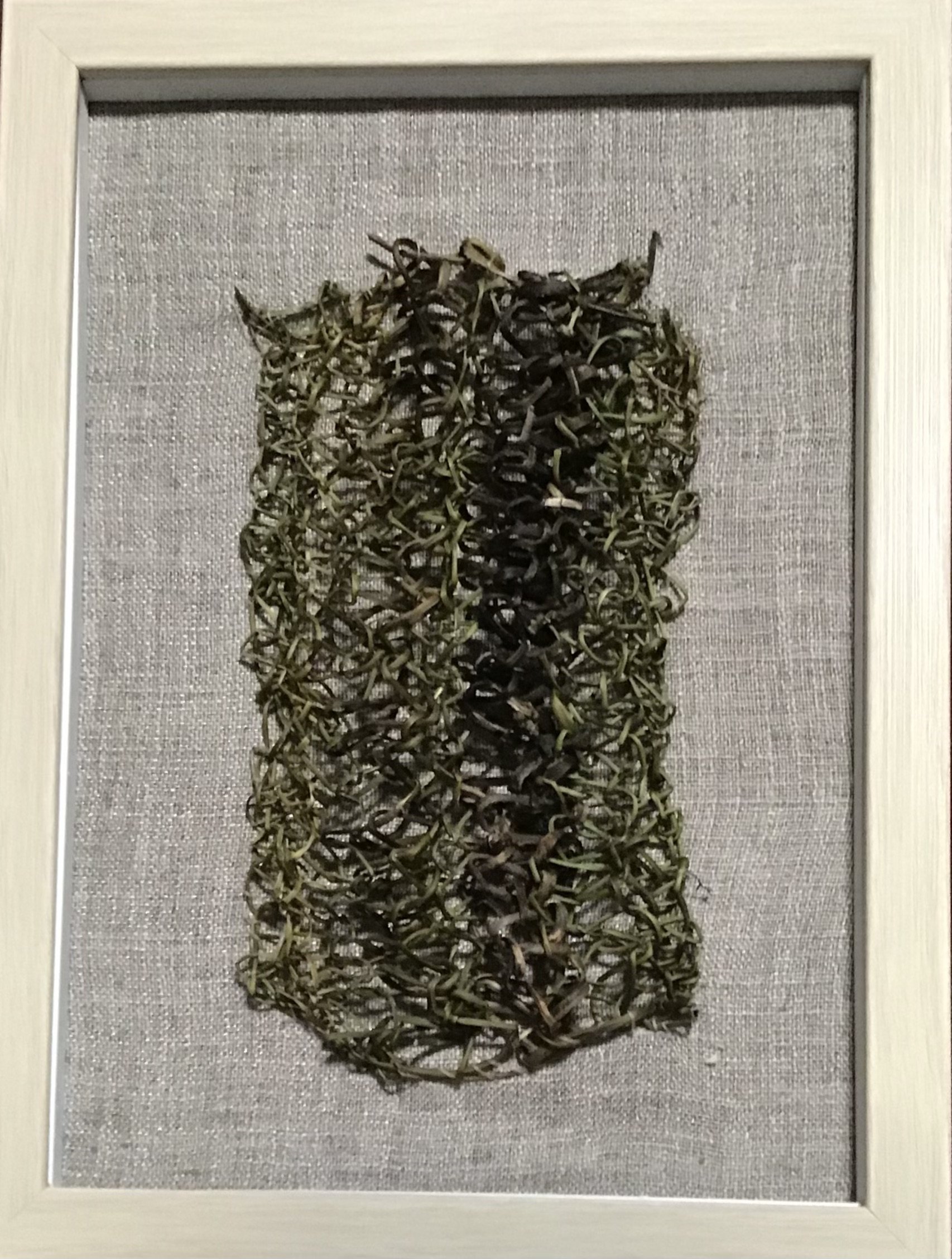
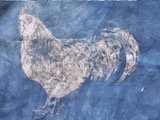

![IMG_8692[1].JPG](https://images.squarespace-cdn.com/content/v1/639f6bda61e0456d11776132/1710043614078-1HUMRUM5LLXJTUN1YYJC/IMG_8692%5B1%5D.JPG)
![IMG_8693[1].JPG](https://images.squarespace-cdn.com/content/v1/639f6bda61e0456d11776132/1710043646022-TPZBHGA986OPXZ1VR478/IMG_8693%5B1%5D.JPG)
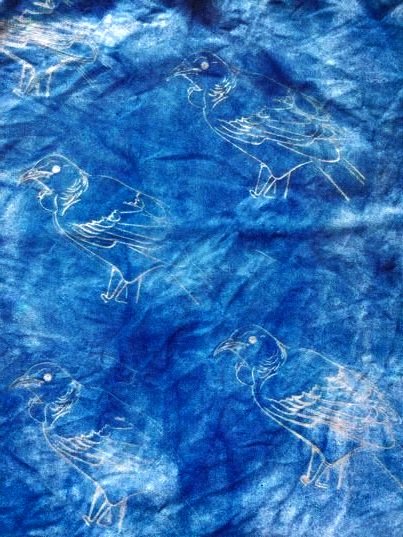
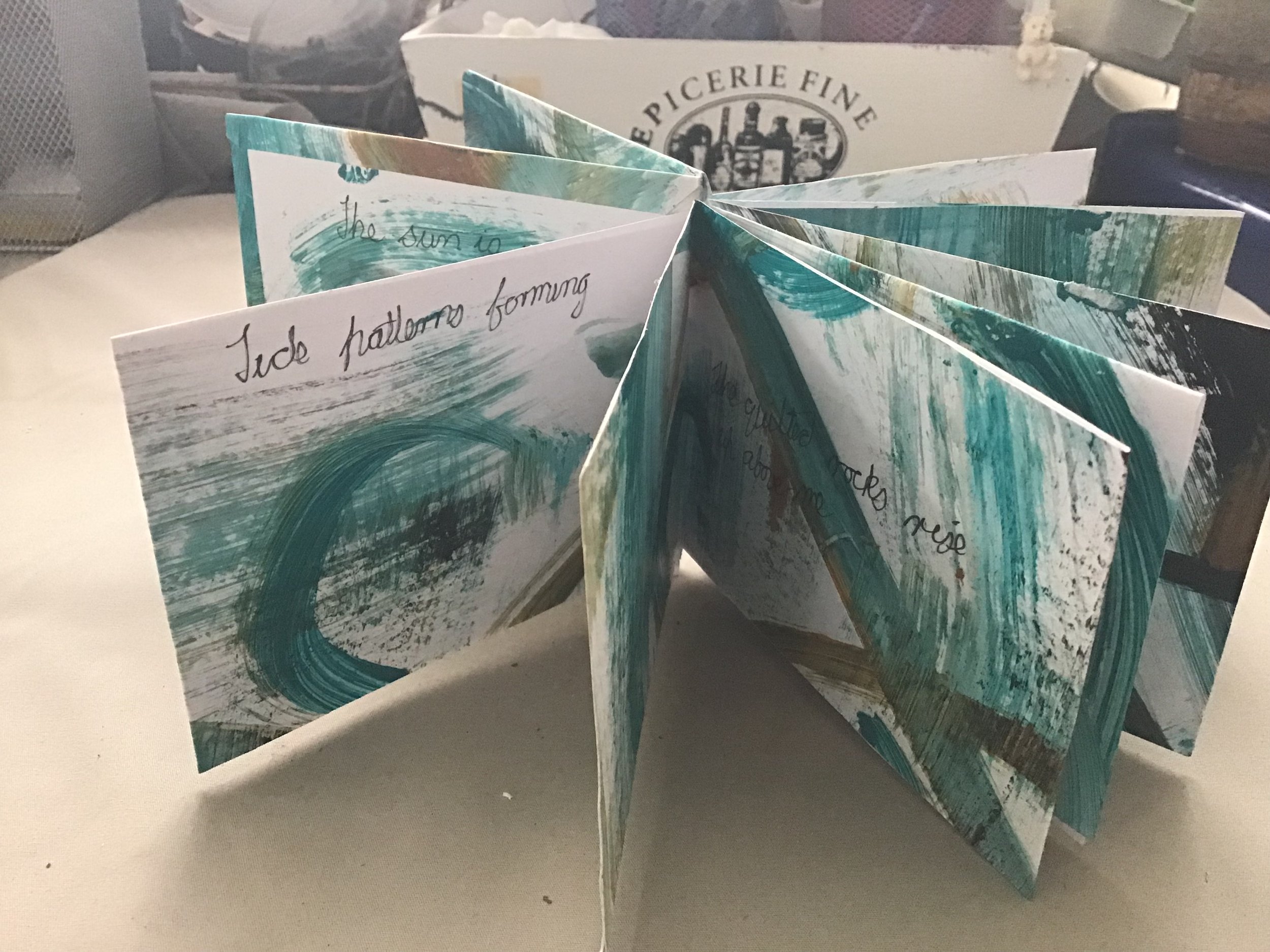

![IMG_8666[1].JPG](https://images.squarespace-cdn.com/content/v1/639f6bda61e0456d11776132/1709349657481-9AID88GYXBI13G3A8E2D/IMG_8666%5B1%5D.JPG)
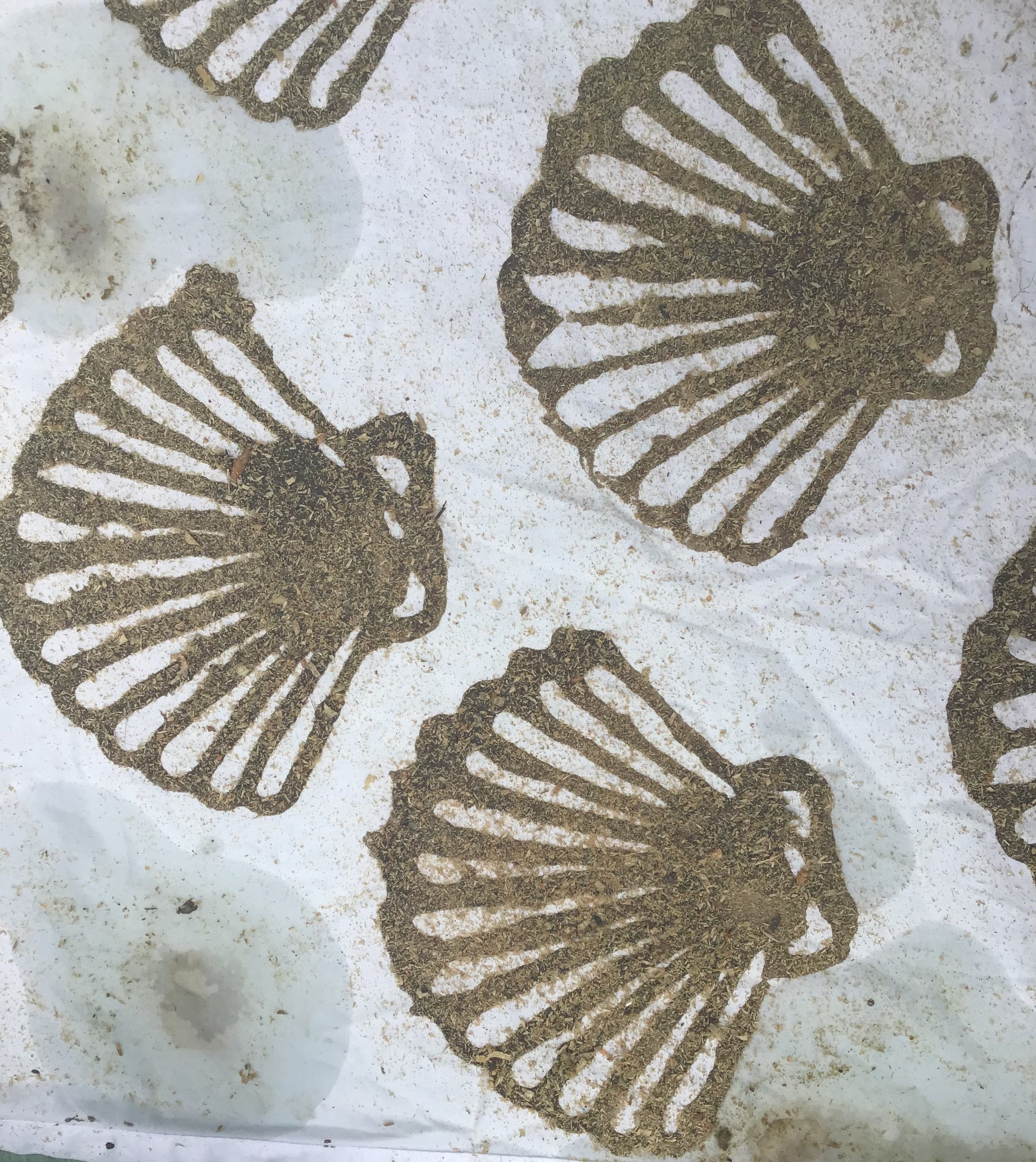
![IMG_8668[1].JPG](https://images.squarespace-cdn.com/content/v1/639f6bda61e0456d11776132/1709349709336-19B5EPKI1DM2QF9O5W06/IMG_8668%5B1%5D.JPG)
![IMG_8669[1].JPG](https://images.squarespace-cdn.com/content/v1/639f6bda61e0456d11776132/1709349729304-EBFN7FTD4F8SD4BMEF0E/IMG_8669%5B1%5D.JPG)
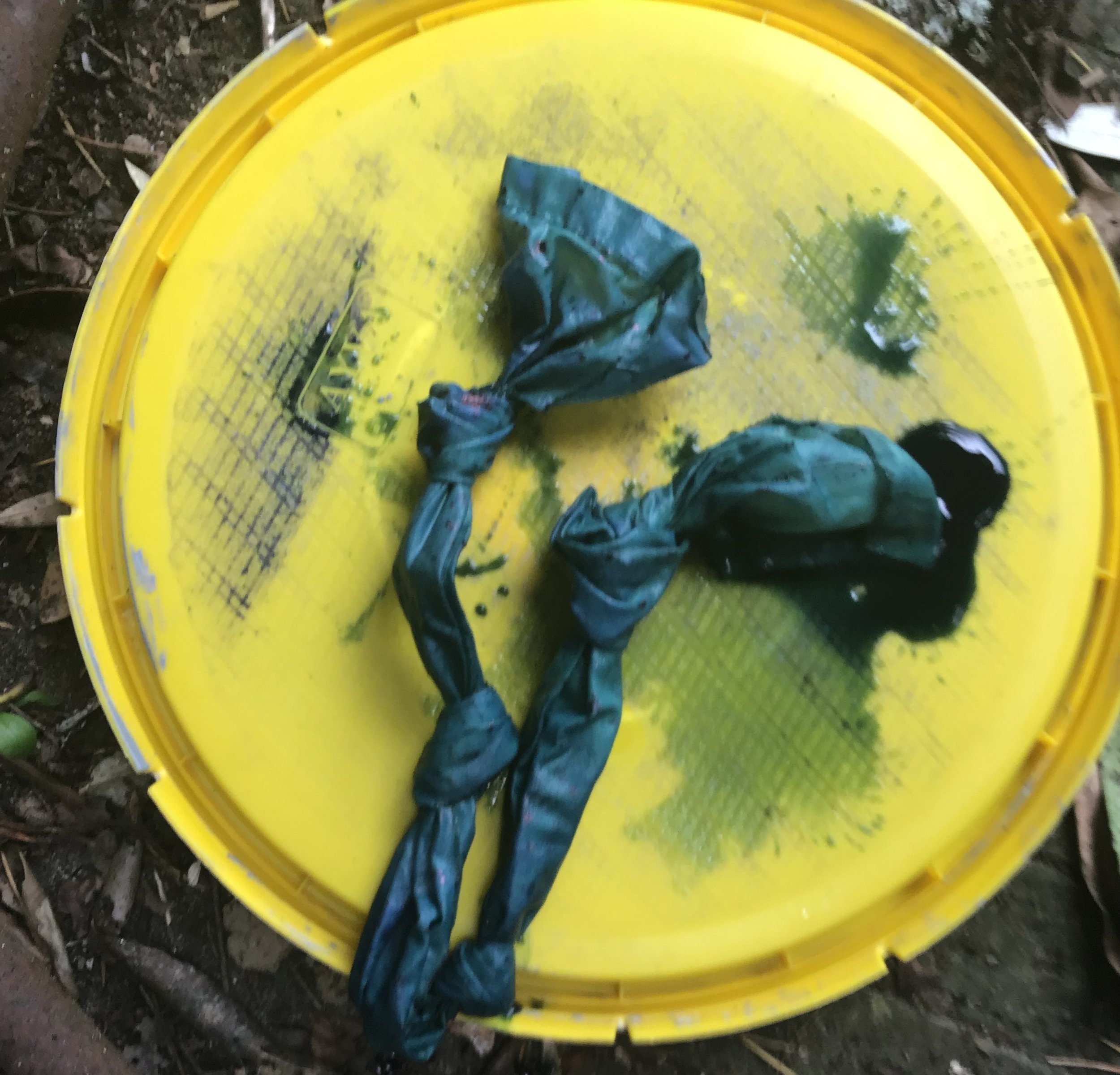
![IMG_8671[1].JPG](https://images.squarespace-cdn.com/content/v1/639f6bda61e0456d11776132/1709349779914-Q2TZR6T4FNYRF06ZLPUQ/IMG_8671%5B1%5D.JPG)
![IMG_8672[1].JPG](https://images.squarespace-cdn.com/content/v1/639f6bda61e0456d11776132/1709349805325-BOOO8ZKAARHH1IEICUT7/IMG_8672%5B1%5D.JPG)
![IMG_8673[1].JPG](https://images.squarespace-cdn.com/content/v1/639f6bda61e0456d11776132/1709349846045-QROPYTIWI0G17UG9M3QJ/IMG_8673%5B1%5D.JPG)
![IMG_8674[1].JPG](https://images.squarespace-cdn.com/content/v1/639f6bda61e0456d11776132/1709349874750-KPHJG0QXRUBA560R440O/IMG_8674%5B1%5D.JPG)